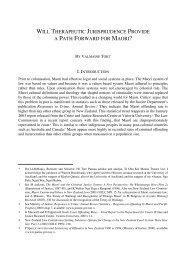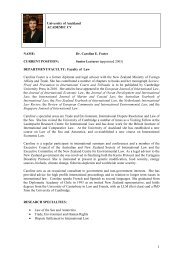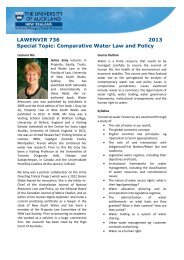Faculty of Law Undergraduate Handbook - Faculty of Law - The ...
Faculty of Law Undergraduate Handbook - Faculty of Law - The ...
Faculty of Law Undergraduate Handbook - Faculty of Law - The ...
- No tags were found...
You also want an ePaper? Increase the reach of your titles
YUMPU automatically turns print PDFs into web optimized ePapers that Google loves.
Content Outline• Difference between close/widely held companies. Different types <strong>of</strong> securities. Why regulate markets? History <strong>of</strong> NZsecurities regulation• Current legislative framework• NZX, Securities Commission, Takeovers Panel• Listed companies. Role <strong>of</strong> the NZX. Obligations <strong>of</strong> the Listing Rules. Key post-admission compliance: materialtransactions, related parties etc. Waivers, rulings, surveillance• Substantial security holder regime and Continuous Disclosure under the Securities Markets Acts 1988• Insider Trading and Market Manipulation• Takeovers — Background• Key concepts in Takeovers Act and Code: “Code Company”, “Voting Security” etc.• Key steps in bid process. Strategies and defensive tactics.• Takeovers Panel• Recent Panel Case Studies• Capital raising under the Securities Act 1978• Overview <strong>of</strong> the structure <strong>of</strong> the 1978 Act, the Securities Regulations 1983, and Exemption Notices• Concepts <strong>of</strong> “the public”, “issues”, and “securities”AssessmentFinal Examination (Plussage 30% Opinion)Prescribed Text/sCopies <strong>of</strong> Securities Act 1978, Securities Markets Act 1988, Takeovers Act 1993, Takeovers CodeLAW 492 — Banking <strong>Law</strong>Credit Points: 15 pointsOffered: First SemesterContact Hours: Lectures — 3 hours per weekCoordinator: Christopher HarePrerequisites: LAW 241 or COMLAW 201Corequisite: LAW 306Restriction: LAW 487, COMLAW 308Course Description:Banking <strong>Law</strong> involves the application <strong>of</strong> basic contractual, tortious and restitutionary principles to the banking context.It also encompasses general and bank-specific legislation dealing with such diverse issues such as the prudentialsupervision <strong>of</strong> banks (Reserve Bank <strong>of</strong> New Zealand Act 1989), the protection <strong>of</strong> consumers in their dealings withbanks (Fair Trading Act 1986, Consumer Guarantees Act 1993), the operation <strong>of</strong> bank payment systems (Bills <strong>of</strong>Exchange Act 1908, Cheques Act 1960) and the prevention <strong>of</strong> money-laundering and the financing <strong>of</strong> other unlawfulactivities (Crimes Amendment Act 1995, Financial Transactions Reporting Act 1996).<strong>The</strong> aim <strong>of</strong> the course is to provide the student with an understanding <strong>of</strong> the basic principles <strong>of</strong> banking law to enablehim or her to deal with the real-life banking law issues that are likely to arise in commercial practice.Content Outline:<strong>The</strong> course will focus on the transactional side <strong>of</strong> banking law rather than upon the regulatory aspects <strong>of</strong> the subjectand will concentrate on the domestic rather than the international aspects <strong>of</strong> banking law (such as documentaryletters <strong>of</strong> credit, standby letters <strong>of</strong> credit, performance bonds and export credit guarantees) as these will be covered indetail in LAW 476 International Sales and Finance. <strong>The</strong> course will not cover the issues arising out <strong>of</strong> banks taking2010 <strong>Faculty</strong> <strong>of</strong> <strong>Law</strong> <strong>Handbook</strong> | 65
















